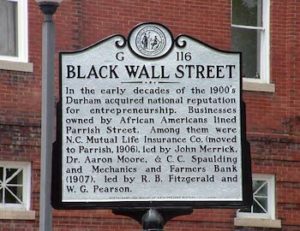
*Black Wall Street is affirmed on this date in 1907.
The Greenwood District in Tulsa, Oklahoma, became known as "Black Wall Street," one of the most commercially successful and affluent majority African American communities in the United States in the 20th century.
Many Blacks came to Oklahoma during the Native American removal. When these tribes came to Oklahoma, their slaves or non-whites living among them as tribal members (notably in the case of the Seminoles) were forced to move with them. This proved problematic as rules concerning the freedom of Blacks differed between tribes. Others later traveled to Oklahoma for the land rushes in 1889 through 1891 and continued in the years leading to November 16, 1907, when Oklahoma became a state (and why we chose this date). Blacks hoped that a majority-black population could build a firewall against further extension of the Jim Crow racial degradation and segregation system.
Booker T. Washington referred to the Greenwood neighborhood as “Negro Wall Street.” Many Americans of all races had moved to Oklahoma, hoping for quick economic gains through the mining and oil industries. Even though Blacks constituted a small percentage of the overall population in Oklahoma, the percentage of Blacks in Tulsa had significantly increased to around 12.3 percent during the oil boom. Many of them had come from the Deep South and Kansas because of the opportunity to strike gold because of the rich oil fields. During Oklahoma’s Jim Crow era, Blacks were prohibited from making purchases or services in predominantly white areas.
In particular, the state had some of the country's harshest and most unjust Jim Crow laws. Some economists theorize this forced many Blacks to spend their money where they would feel welcomed, effectively insulating cash flow within their community and allowing Greenwood to flourish. In "Black Wall Street," Black attorneys, real estate agents, entrepreneurs, and doctors offered their services in the neighborhood. Ottowa W. Gurley and J.B. Stradford illustrate one primary example of the Black entrepreneurial spirit.
Stradford had graduated from Indiana University with a law degree and moved to Greenwood to purchase land vacancies in the area. After buying these vacant spaces, he would sell them to Black residents for redevelopment so that these empty spaces could be transformed into residential houses and profitable businesses. By 1921, Stradford had been considered one of the wealthiest Blacks in the country as he owned numerous properties in Greenwood and even had his hotel named after him: Stratford Hotel.
In addition to Stradford, Gurley, and others, there were investments and reinvestments in the community. One executive of the local YMCA recalled several barbershops, several grocery stores, and even a funeral home service. Greenwood was known to be an active religious community, with numerous Black-owned churches, Christian youth services, and other religious organizations.
The white-American racial resentment against Blacks from slavery through Jim Crow erupted on May 31, 1921, with the Tulsa Race Riot. Three hundred, mostly black people, died in the Tulsa Race Riots at the hands of a white-American mob. One of the worst race riots in U.S. history; it lasted two days. Hundreds of people were injured, and over 1,000 Black-owned homes and businesses on Black Wall Street were destroyed.
Within ten years after the massacre, surviving residents who chose to remain in Tulsa rebuilt much of the district. They accomplished this despite the opposition of many white Tulsa political and business leaders and punitive rezoning laws enacted to prevent reconstruction. It continued as a vital black community until the federal government overturned segregation during the 1950s and 1960s. Desegregation encouraged black citizens to live and shop elsewhere in the city, causing Greenwood to lose much of its original vitality. Since then, city leaders have attempted to encourage other economic development activities nearby.
The Greenwood Cultural Center, dedicated on October 22, 1995, was created as a tribute to Greenwood's history and a symbol of hope for the community's future. The center has a museum, an African American art gallery, and a large banquet hall and housed the Oklahoma Jazz Hall of Fame until 2007. The total cost of the center was almost $3 million. The cultural center is a very important part of the reconstruction and unity of the Greenwood Historical District. The center sponsors and promotes education and cultural events preserving African American heritage. It also provides positive images of North Tulsa to the community, attracting a wide variety of visitors, not only to the center itself but also to the city of Tulsa.
In 2011, the Greenwood Cultural Center lost all funding from the State of Oklahoma, threatening its existence. The community responded with donations and GoFundMe campaigns, and the Cherokee Nation contributed to its summer programs. Businessman Michael Bloomberg donated one million dollars to the Greenwood Art Project in 2019 and made it his first stop on his campaign for the Democratic presidential nomination on January 19, 2020.